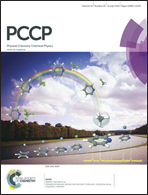High energy conformers of M+(APE)(H2O)0–1Ar0–1 clusters revealed by combined IR-PD and DFT-MD anharmonic vibrational spectroscopy†
Abstract
IR-PD vibrational spectroscopy and DFT-based molecular dynamics simulations are combined in order to unravel the structures of M+(APE)(H2O)0–1 ionic clusters (M = Na, K), where APE (2-amino-1-phenyl ethanol) is commonly used as an analogue for the noradrenaline neurotransmitter. The strength of the synergy between experiments and simulations presented here is that DFT-MD provides anharmonic vibrational spectra that unambiguously help assign the ionic clusters structures. Depending on the interacting cation, we have found that the lowest energy conformers of K+(APE)(H2O)0–1 clusters are formed, while the lowest energy conformers of Na+(APE)(H2O)0–1 clusters can only be observed through water loss channel (i.e. without argon tagged to the clusters). Trapping of higher energy conformers is observed when the argon loss channel is recorded in the experiment. This has been rationalized by transition state energies. The dynamical anharmonic vibrational spectra unambiguously provide the prominent OH stretch due to the OH⋯NH2 H-bond, within 10 cm−1 of the experiment, hence reproducing the 240–300 cm−1 red-shift (depending on the interacting cation) from bare neutral APE. When this H-bond is not present, the dynamical anharmonic spectra provide the water O–H stretches as well as the rotational motion of the water molecule at finite temperature, as observed in the experiment.


 Please wait while we load your content...
Please wait while we load your content...